by Romina Ciulli e Carole Dazzi
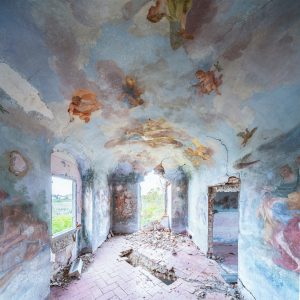
What is photography if not the ability to tell reality, interpreting what appears before our eyes through countless experiential dimensions, transforming a subjective gaze into a unique vision, revealing a secret aspect that will continue to remain so emotional? This is what it feels when we approach the works of Nicola Bertellotti, a Tuscan artist, who has transposed this conceptual methodology of the photographic medium to the places explored during his travels.
Abandoned, forgotten places, scenarios in ruins, wrapped in melancholy and romantic atmospheres. Here time has stopped, but it continues to echo the past scenarios, if not even future. It is precisely from this cue that Bertellotti’s artistic research starts: with his shots he bears witness to the reverberations of the past and the transience of an existence which, by reaffirming its innate beauty in an irrepressible way, never ceases to speak to us about our present, our identity, our society. A work, therefore, characterized by strong emotional implications, by imaginative visions, in some ways dreamlike and disturbing, which crosses the barriers of time to arrive at those of historical and collective memory. Among his works, we mention the series The Great Beauty (2018), Picturesque (2021), Restitution (2021), Hic Sunt Dracones (2016) and the photographic books Fenomenologia della Fine (2013) and In Absentia. The Modern Ruins of Europe (2022). Let’s talk with the artist.
Your shots represent a decadent and melancholy reality. However, the vision of these abandoned places generates an unexpected emotional appeal in the viewer, a sort of fascination for the destabilizing beauty emanating from those scenarios. What are the reasons behind your artistic research?
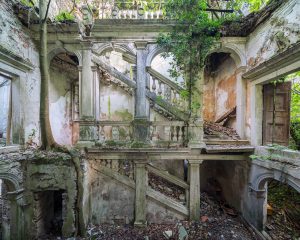
I have always been attracted by the epiphany of these places, by their epic and by their definitive disappearance. The obsolete objects and dilapidated rooms in my work have the same function that the madeleine has in Proust, that of evoking the memory of a happy age. I’m not interested in mere abandonment but in the sign of time, in the various stratifications which then define the decadence of an environment.
In your artistic career you have been influenced by important writers and artists. Among these John Ruskin, who in the essay The Seven Lamps of Architecture (1849) theorized an existential relationship between man and the architecture which surrounds him, emphasizing how fundamental this bond is for building our past, present, but also future. This element is found, for example, in the series entitled The Great Beauty (2018). Can you tell us about this project and how these places bear witness to this concept?
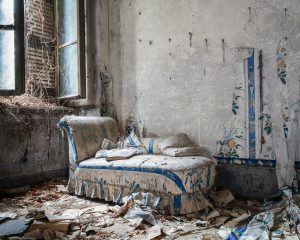
If man, to protect his works from the wear and tear of time, had no other means of defense than resorting to “falsifying” restoration, then Ruskin suggested, rather than populating the world with altered and no longer authentic buildings, it would have been desirable to abandon them to degradation and their own fate. Taking up some of his theses, I also imagine a perfect building as one to which time has brought the final touch. The places that are part of The Great Beauty series are real lost paradises that reveal the painful awareness of their past glory but it is the addition: beauty + time that makes them so special.
Another aspect that characterizes your work is the romantic spirit. The places you show in projects such as Picturesque (2021) or in Restitution (2021) emanate a nostalgic poetics, which brings us back not only to the transience of life, but to the very origin of nature and existence. So how can these ruins become the metaphor of a progressive return to primordial harmony?
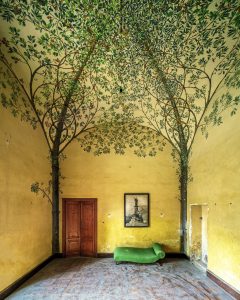
I celebrate the modern ruin as an architectural element in which the decadence of human work, following its abandonment and the progressive reconquest of its space by nature, despite having in itself the tragic nature of progressive destruction, is, however, the place of perfect harmony between the spiritual tension of man and the material forces of nature. The charm of the ruin derives, in fact, from its being progressively returned to nature, which has the opportunity to spread its veil over the work of man, giving life to a new form of beauty that draws its origins from the sense of decadence that all pervades.
Another character who has somehow influenced your research is Nicolas Bouvier, who in the book “The dust of the world” (L’usage du monde, 1963) tells of his journey to discover enchanted places, but above all of himself. How much do your photographs tell us about our society, our identity, ourselves?
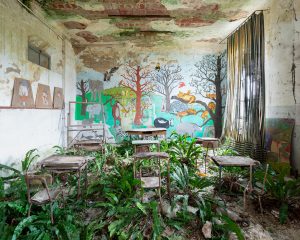
We should deal with the rubble just as we should our wounds, our failures. Continuously superimpose the topography of the landscape on our inner topography. Don’t remove, but listen to the abandonment, take care of it, look after its part of who we are, of our history and our future. To do all this we must fill ourselves with melancholy and amazement. We should never add forgetfulness to abandonment, as long as we still mention its name, then the ruins will always stand. But if for whatever reason we forget a fraction, a locality, if in a hurry we leave out the name of a ghost town, out of lightness and superficiality, then everything will collapse again.
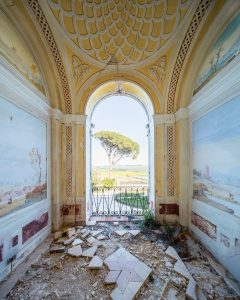
In Absentia. The Modern Ruins of Europe (2022) is a photographic anthology where the main character seems to be the man. Or rather the man who is no longer there, who is missing, who is absent. That same man who built those places, who lived in them, used them, loved them, and of whom only a vague trace remains in the collective memory. How important is memory in your work?
At the end of Woody Allen’s film “Another Woman” the protagonist wonders if memory is something we have or have lost forever. Here, at the basis of my latest book, there is precisely the tension between these two possible answers. They are both true and false. Like the human presence in these places, so empty but at the same time still full of (past) life.
Instead in the exhibition Hic Sunt Dracones (2016) you present a series of images of abandoned places located all over the world that come back to life thanks to nature. In every shot, in fact, we seem to witness a sort of emotional reconquest: no longer forgotten ruins, but memories of a happy experience. Can you tell us about this project?
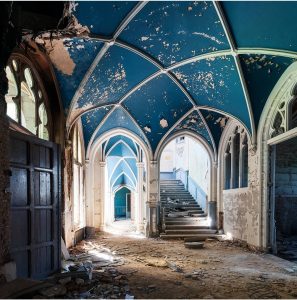
“Hic sunt dracones” is an expression that was associated with ancient geographical maps to indicate still unexplored areas. I entitled my exhibition in this way precisely to lift the veil on many places in our country that have now returned to being off the map. My intent is to show all this invisible geography that surrounds us. Every day we all pass with indifference in front of places that still hide so much beauty and real treasures.
A similar experience occurs in the book Fenomenologia della fine (2013): industries, villas and churches in ruins that seem to acquire a new role from the original one, namely that of memory. How much does the photographic medium help to restore this collective value?
Relatively because it is the subject, in this case the ruined places, that made me a photographer. If I had other talents I would have used another medium. If I were a good painter I would paint their architecture, if I knew how to write they would become the background of my novels.
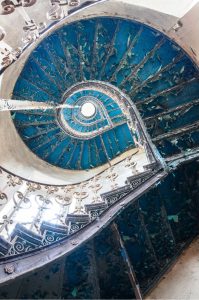
In 2022 you participated in the Il Bosco in una Serra project: a traveling exhibition, located in Valdelsa, dedicated to the search for a more harmonious and lasting relationship between man and nature. In this case your photographs related to the works of the sculptor Hermann Josef Runggaldier through an intense emotional dialogue. Can you tell us about this experience?
The works on display could ideally all be part of Gilles Clément’s “Manifesto of the Third Landscape“. How can we define the third landscape? They are occupied by empty, marginal spaces devoid of human beings, those that can transform themselves into refuges of diversity, undecided places, devoid of functions, which do not express submission to power and are marvelously useless.
Are there any photographers who have inspired your artistic path?
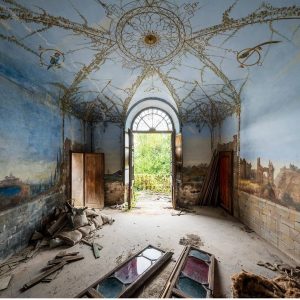
I want to mention two names that for me are real pillars of contemporary photography: Robert Polidori, especially his splendid work on Cuba, and Edward Burtynsky, with his magnificent visions from the Anthropocene.
Can you tell us about your future projects?
At the beginning of February I will be on show for the first time in Spain, in Barcelona. It is a group exhibition curated by Eliana Urbano Raimondi and the title is “Inventarium”.